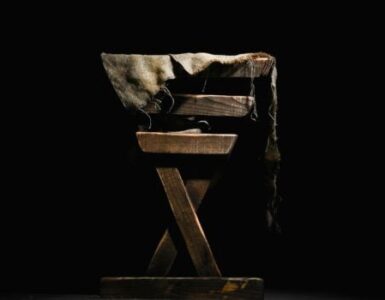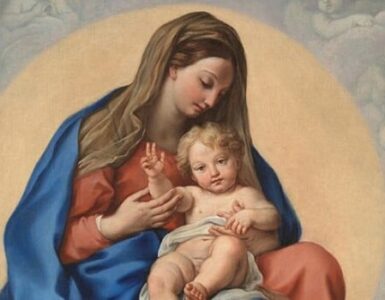There are some details in salvation history which cry out to the masses: this is important! From the very beginning, literally, the symbol of wood from a tree is critical. God desires to use this weaving thread of continuity found in his love letter to the world (the Bible) to reveal something radically beautiful about who he is and who we are called to be.
Adam and Eve can eat fruit from any tree except for the one in the middle of the garden, the tree of the knowledge of good and evil (Gen 3:3). They are told that if they eat of this tree, they will die. Here, we gain insight into the mindset of God from the outset of his creation of humanity: we were meant to live forever, body and soul. The serpent arrives and tempts Adam and Eve to take the fruit because of how wonderful it appears, and the fact that if they eat of it “they will become like gods” (Genesis 3:5). The tree is the means by which sin, evil and death entered the world.
The wood of the tree brought harm to the human race because we thought we could determine what was right and what was wrong. All sin is, therefore, a repeat of this first one. It is a combination of a lack of trust in God, selfishness, and greed. We do not really buy it that God has given us enough, we want to take rather than give, and we we want more even though we have been given everything. The spiritual life is a constant journey revolving around the tree of the knowledge of good and evil and our often pursuit of trusting our own desires over what God has in store for us. The wood of this tree lingers in the shadows as humanity continues to reject God and choose themselves.
When Noah arrives on the scene we are told that he is the only one on earth who is blameless and righteous (Genesis 6:9). A flood is sent, not out of God’s hatred, but out of a spiritual physics. The earth was filled with those who were not really alive in body and soul. They were corrupt and God desired to begin a new covenant. The tree had won out in their hearts, so Noah was directed to build an ark made of wood (Genesis 6:14). This vessel, made out of the lumber from trees, would become the salvific instrument for humanity. Just as it appears that the evil of the tree was victorious, God decides to use the wood of the tree to redeem and save.
As the Bible progresses we travel through the Tower of Babel and arrive at the time of Abraham. He and his wife Sarah are elderly and have been deemed infertile. God calls Abraham to be the father of the nations even though he has no offspring. His radical trust singles him out as the blueprint for faith in God. Once a son is born to him in Isaac, there is great jubilation and fulfillment. Until God asks Abraham to offer Isaac back to him, to slay his firstborn son, the one who will ensure that the covenant which was promised to Abraham is fulfilled (Genesis 22:2).
Abraham does not hesitate. He tells his son they are going to make an offering and they make their way up a mountain. An easy and often overlooked detail is the fact that Isaac is carrying the wood for the offering because his father “took the wood…and laid it on his son” (Genesis 22:6). Picture the son carrying the wood on his shoulders as climbs the hill to his death. At the very instant before that Abraham is about to come down with the knife, the angel of Lord stops him from doing so (Genesis 22:12). In Isaac’s place, they find a “ram caught with its horns in a thicket” (Genesis 22:13) and offer it to God on the altar. A thicket is literally a dense group of trees or bushes. The ram was caught in trees and was made the offering. The son who carried the wood up a hill for an offering which was going to be his own life was not accepted, God would do this for himself.
Wood also plays many roles in the life of Moses. From his calling at the burning bush (Exodus 3) to his staff turning into a serpent in front of pharaoh (Exodus 7:10), to his staff being the instrument which parts the Red Sea (Exodus 14:16), it is clear that this theme continues. Most striking, among the wood of the tree implications is the serpent mounted on a wooden pole (Numbers 21). The Israelites are being bitten by serpents and dying in droves. God directs Moses to mount a bronze serpent on a wooden pole and have the people look upon it after they have been pierced by the serpent. Looking upon the wood will save them and will eventually save us.
The connections between these previous occasions in the Bible and the life of Christ are both obvious and beautiful. When God becomes one of us he is placed in a wooden feeding trough for animals – a manger (Luke 2:16). Jesus’s foster father is a carpenter whose life work is made up of molding and crafting objects out of wood. Jesus would have been in the workshop learning these things from his step-dad and they both would have been able to recall the countless stories in the Scriptures of God’s own carpentry work. Jesus’ best friends and disciples were fishermen who made their living by working in wooden ships.
Ultimately, Jesus dies on the wood of a cross. This is the moment our salvation is won and the initial evil which triumphed around the wood of the tree in the garden is redeemed. As Christ embraced his cross, carried it, was nailed to it, and hung upon it he must have been in agonizing contemplation of just how much the wood he was on would affect every soul.
From beginning to end, the wood of the tree exclaims to the world that we are in desperate need of saving, and that we can overcome the sin of the tree if we cling to love personified on the wood of the cross.
Blessed are we who have a savior who is born at Christmas and dies on Calvary.
✠












